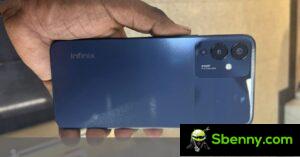Redmi by Xiaomi launched Redmi K20 and K20 Pro in India in 2019 and those were quite popular in their time. And after a three-year hiatus, the company has finally launched a K-series smartphone in India, dubbed the Redmi K50i.
However, the Redmi K50i is not a completely new smartphone. It is a version of the Poco X4 GT that is available outside India. We have already reviewed the Poco X4 GT, and you can read its detailed review here, but let us tell you that there are some differences between the two smartphones as the Redmi K50i is not a fully rebranded X4 GT. Read on to find out the differences.
Unpacking
Let’s check the retail box of the Redmi K50i first. Unlike the Poco X4 GT, which comes in a black box with yellow lettering, the Redmi K50i comes in a white box with some smartphone features mentioned on one side of the lid.

The contents of the package are the same, though. You get a protective case, a SIM eject tool, and the usual paperwork. Also includes a USB-C cable and 67W charger.

Design
The Redmi K50i is built around a 6.6″ FullHD+ Field Fringe Switching (FFS) LCD (X4 GT has IPS LCD) protected by Gorilla Glass 5. The panel has a 7-stage 144Hz adaptive refresh rate and a 270Hz touch sampling rate, which can only be achieved at a refresh rate of 90Hz or lower. The display also supports HDR10+ and Dolby Vision.
However, unlike the Redmi K20 and K20 Pro, the Redmi K50i doesn’t come with a pop-up selfie camera. Its selfie camera, which uses a 16MP sensor, is located inside the central hole in the screen.

Flip the Redmi K50i over and you have a polycarbonate back with a rectangular camera island and Redmi branding. The back cover is made from plastic, so you don’t get a premium feel in your hand that you would get from a glass back. However, the panel has a matte finish to make up for that. It did a good job of preventing fingerprint smudges, but it made the phone slippery at times.

We got the Phantom Blue version of the Redmi K50i which looks great with its subtle glitter pattern and hue that changes as light hits it from different angles.

The island at the back, also with a matte finish, houses an LED flash with three cameras. It sticks out a bit, with two cameras sticking out further, causing the smartphone to wobble when used on a flat surface.

The Redmi K50i has flat bezels, with the one on the right side housing the volume rocker and power button. They are plasticky but have decent feedback.
The power button doubles as a fingerprint scanner, and we found it to be fast and accurate. It also supports double-tap gestures to let you perform various actions, including taking a screenshot, launching the default camera app, and opening control center.
At the bottom, the Redmi K50i has a USB-C port, flanked by a speaker grille and a dual-SIM card slot. Up top, we have another speaker, joined by a 3.5mm headphone jack and IR blaster.



Redmi K50i
The Redmi K50i is 8.9mm thick and weighs 200g. Considering the screen diagonal of 6.6″, these are reasonable dimensions, but of course it’s not a small phone.
Screen
Redmi K50i’s 6.6″ LCD display has a peak brightness of 650 nits. It comes with DC Dimming and supports HDR10, HDR10+ and HLG standards. It also has Widevine L1 certification, which means you can stream FullHD video on supported OTT apps.
For an even better media experience, get Dolby Atmos and Dolby Vision. The latter is not even present on the more expensive Xiaomi 12T, powered by the Dimensity 8100-Ultra.
The Redmi K50i’s display has good haptic feedback. It’s bright enough to read textual content in bright conditions and comes with adaptive colors, which adjust to ambient light. But what impressed us the most about the Redmi K50i’s screen is the high refresh rate.

The K50i has refresh rate options of 60Hz, 90Hz, and 144Hz in the custom refresh rate menu, and supports seven refresh rates in total: 30Hz, 48Hz, 50Hz, 60Hz, 90Hz, 120Hz, and 144Hz. These change automatically depending on the content and settings.
By default, the refresh rate is 120Hz for most system menus and apps, whether you’re interacting with the screen or just looking at it, with the exceptions of YouTube (60Hz) and Google Photos ( 90Hz).
The refresh rate should remain at 60Hz in the 60Hz mode for everything, while the 90Hz mode was basically the default mode with the refresh rate reduced from 120Hz to 90Hz, except for Google Photos, which remained limited to 60Hz.
Things change with the 144Hz mode, though. The display also refreshed to 144Hz for Google Photos, and while YouTube remained limited to 60Hz, in full screen mode it matched the refresh rate of recorded video at a lower FPS. Some videos played at 30Hz, 48Hz and 50Hz in full screen mode, and the panel switched to 60Hz when you interacted with the screen.

As for games, we tried Call of Duty Mobile, Dead Trigger 2, Real Racing 3 and Sky Force Reloaded on the Redmi K50i. With the exception of Call of Duty Mobile, we were able to play all other games at 90 FPS (in 90Hz mode), 120 FPS (in default mode) and 144 FPS (in 144Hz mode).
The HRR implementation on the Redmi K50i is way better than the Poco X4 GT, which only played Real Racing 3 and Sky Force Reloaded at 120FPS, and the system never jumped to 144Hz no matter what. There’s no point in selling a phone with a 144Hz screen if the system doesn’t go 144Hz.
But the HRR implementation on the Redmi K50i is easily one of the best for a smartphone featuring a non-LTPO screen type. And if you’re someone for whom battery life is more important, then we’d suggest sticking with the 60Hz mode or perhaps the 90Hz mode for a more balanced approach.
Software and performance
The Redmi K50i has the Dimensity 8100 SoC at the helm, flanked by the Mali-G610 MC6 GPU to handle graphically intensive tasks like gaming and video editing. The smartphone comes in 6GB/128GB and 8GB/256GB storage variants. We got the latter, and whichever you choose, you get LPDDR5 RAM and UFS 3.1 storage.
On the software front, the Redmi K50i starts MIUI 13.0.2 Global based on Android 12 with the June 2022 Android security patch, and currently runs MIUI 13.0.7 with the October 2022 security patch, which is not appreciated since December is almost finished. The smartphone comes pre-installed with a few third-party apps, but fortunately most of them can be uninstalled if desired.

The software experience you get on Redmi K50i is similar to what you get on other Redmi devices running Android 12 and MIUI 13.
The Redmi K50i offered a snappy and smooth everyday experience, talking web browsing, switching apps and games with ease. There were almost no stutters. The smartphone remained reasonably cool even after more than an hour of heavy gaming.
GeekBench 5 (multicore)
Higher is better
-
Little X4GT
3719 -
Redmi K50i
3707 -
Little F4GT
3637 -
Realme GT Neo 3T
3180 -
Realms 10+
2371 -
Redmi Note 11 Pro 5G
2063 -
Galaxy A33 5G
1900
GeekBench 5 (single-core)
Higher is better
-
Little F4GT
1244 -
Realme GT Neo 3T
1023 -
Little X4GT
917 -
Redmi K50i
916 -
Realms 10+
842 -
Galaxy A33 5G
742 -
Redmi Note 11 Pro 5G
688
GFX Car Chase ES 3.1 (on screen)
Higher is better
-
Realme GT Neo 3T
49 -
Redmi K50i
48 -
Little X4GT
46 -
Realms 10+
21 -
Galaxy A33 5G
20 -
Redmi Note 11 Pro 5G
17
GFX Manhattan ES 3.1 (on screen)
Higher is better
-
Redmi K50i
ninety two -
Realme GT Neo 3T
85 -
Little X4GT
54 -
Realms 10+
38 -
Galaxy A33 5G
35 -
Redmi Note 11 Pro 5G
30
Camera and battery
The Redmi K50i has four cameras in tow: a 16MP selfie camera at the front, with the 64MP main camera at the rear joined by 8MP ultrawide and 2MP macro units. The selfie camera has an f/2.5 aperture and can shoot videos in up to 1080p resolution at 30 FPS.

The 64 MP main camera, on the other hand, has an f/1.9 aperture and can record video in 1080p at up to 60 FPS and in 4K at 30 FPS. The 8MP ultrawide unit has a 120-degree FOV and f/2.2 aperture, while the macro camera is f/2.4.

Since the Redmi K50i’s camera system is the same as the Poco X4 GT, you can check out our Poco X4 GT camera tests here to get an idea of what to expect from the Redmi K50i in terms of photography.
The Redmi K50i, like the Poco X4 GT, has a 5,080mAh battery under the hood with support for 67W wired charging.
We failed to run our standard battery tests on the Redmi K50i, but anecdotally speaking, we consistently got at least 6-6.5 hours of screen-on time on a single charge in 144Hz mode over Wi-Fi connection, with the usage including web browsing, using social media apps, streaming 1080p YouTube videos, and playing games.

Once the battery runs out, you can use the bundled 67W adapter for recharging, which is advertised to charge the Redmi K50i’s cell from zero to 50% in 15 minutes and 100% in 46 minutes.
In our tests, the Redmi K50i’s battery charged from empty to 35% in 15 minutes, 50% in 22 minutes, 64% in 30 minutes and 100% in 53 minutes. The Poco X4 GT charged the most in 30 minutes (75% vs 64%), but it also took longer to fully charge (57 minutes vs 53 minutes) as it slowed down much more aggressively.
Conclusion
The Redmi K50i is offered in Stealth Black, Quick Silver and Phantom Blue colors. Its 6G/128GB model is currently priced at INR 23,999 ($290/€272) and the 8GB/256GB version at INR 26,999 ($326/€306), or INR 2,000 ($24/€22) in cheaper than the launch price. It’s a really good phone at the price for what you’re getting: snappy performance, good battery life with fast charging, and impressive HRR implementation. The cameras take decent photos even during the day.
The plastic back and LCD panel of the Redmi K50i might be a deal breaker for some, and if that’s more important to you, then you might want to look elsewhere. The Xiaomi 11i HyperCharge, known as the Redmi Note 11 Pro+ outside India, is one of the options.

The Xiaomi 11i HyperCharge is currently priced at ₹24,999 ($302/€283) for the 6GB/128GB version and ₹26,999 ($326/€306) for the 8GB/128GB model GB. It packs an AMOLED screen and sports a glass back, as well as support for 120W wired charging, a 108MP main camera, and an IP53 rating.
However, the 11i HyperCharge is powered by the 6nm Dimension 920 chip and comes with a 4,500mAh battery, resulting in shorter battery life than the Redmi K50i. You can read our Xiaomi 11i HyperCharge review to learn more.







Start a new Thread